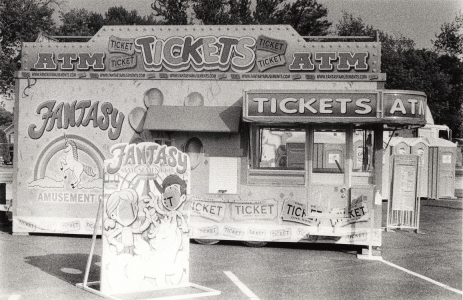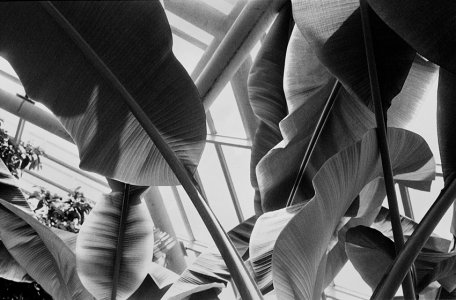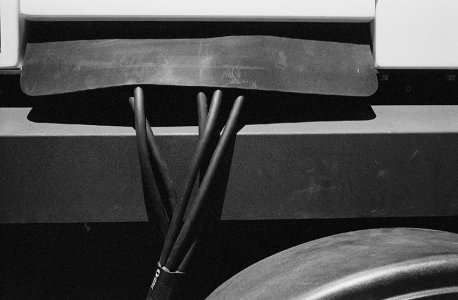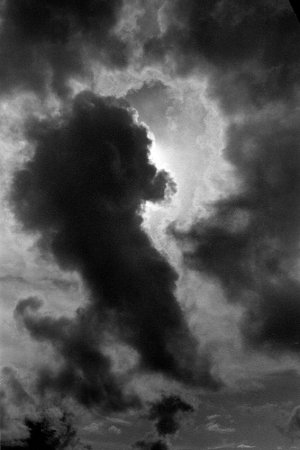Jonathan R
Well-known
You are perfectly right. That’s basically what I was trying to say, only I wasn’t clear. I meant increase dev time to try to compensate for decreasing exposure. But that would certainly not ‘rescue’ shadows that were inadequately exposed, and it would send those mid-tones back up the slope, so it’s pointless.Freakscene will correct me, but I would expect that reducing time in Part A might lower the curve a bit, albeit at the expense of the highlights? The upper mid tones have developed more density than you desire, so need less development. Probably, your shadows won’t be affected much (or at all) as they will be fully developed more quickly and with less developer in any case.
However, I haven’t enough time with 2 baths to be sure and so look forward to more and reliable info.
Freakscene
Obscure member
No correction. More exposure is exactly what I would suggest first, and the problem with looking only at zone vii density.Freakscene will correct me, but I would expect that reducing time in Part A might lower the curve a bit, albeit at the expense of the highlights? The upper mid tones have developed more density than you desire, so need less development. Probably, your shadows won’t be affected much (or at all) as they will be fully developed more quickly and with less developer in any case.
However, I haven’t enough time with 2 baths to be sure and so look forward to more and reliable info.
Xtol on its own will provide a much more balanced negative and better speed, but divided D-76 or pseudo divided Xtol will also likely give more balanced midtones. But I’d try more exposure first.
And if you are patient and have a big developing tank, you can also try long development in Xtol 1+4 or 1+5 for comparison, but you need 100mL of stock per roll. So you can only develop one or two rolls at a time unless you have a huge tank.
Marty
Jonathan R
Well-known
Thanks again, Marty. I am persuaded: I will give XTOL a try, and tinker further with the BT2B. On the latter score, please could you un-confuse me? Earlier you wrote:No correction. More exposure is exactly what I would suggest first, and the problem with looking only at zone vii density.
Xtol on its own will provide a much more balanced negative and better speed, but divided D-76 or pseudo divided Xtol will also likely give more balanced midtones. But I’d try more exposure first.
And if you are patient and have a big developing tank, you can also try long development in Xtol 1+4 or 1+5 for comparison, but you need 100mL of stock per roll. So you can only develop one or two rolls at a time unless you have a huge tank.
Marty
but now you writeYou could expose a little less, or develop a little less
🤔More exposure is exactly what I would suggest first
Freakscene
Obscure member
Sorry - I would suggest a ‘ring around’.Thanks again, Marty. I am persuaded: I will give XTOL a try, and tinker further with the BT2B. On the latter score, please could you un-confuse me? Earlier you wrote:
but now you write
🤔
Shoot a scene relevant to your normal subjects at -1 stop, iso speed and +1 stop on three separate pieces of film. Then develop under, normal and over normal time. Normal is usually 3+3, and 4.5+4.5 is good for over, but under is a bit tricky. 2.5+2.5 or 2.5+3 works ok, but generally developing ‘less’ isn’t necessary for 2 bath processes.
Once the films are developed, print them. Don’t rely on zone vii density, print and look at the whole photo and see what looks best. This used to be standard practice.
With BT2B/divided D-23 don’t be surprised if the upper mids and highlights compress whatever you do. That’s why I’d suggest divided D-76, or at least adding a little hydroquinone. The David Vestal divided D-76 was the best one I tried.
If you try Xtol, X-T3, Legacy Eco Pro or Moersch Eco, use distilled water to mix and dilute and try it first. Don’t blow important photos experimenting.
Marty
Sanug
Well-known
I use XT-3 with tap water and never had an issue like the "sudden death". XT-3 works very reliable due to my experience.
Freakscene
Obscure member
It very strongly depends on your tapwater. Ascorbate developers are very sensitive to divalent cations (the 2+ ones) especially iron and manganese. These developers include products to sequester or complex them out of the water (usually edta, Sodium Hexametaphosphate or Sodium Tripolyphosphate) but if there is enough iron in the water it saturates the sequestering agents and interferes with development. Maybe you live in an area where the water is low in iron, but I have no idea where @Jonathan R lives or what the water is like there. Deionised or distilled water is cheap and good insurance. Ascorbate developer loss of activity is very real.I use XT-3 with tap water and never had an issue like the "sudden death". XT-3 works very reliable due to my experience.
Last edited:
Jonathan R
Well-known
I don’t really do important photos! 😉 But yes, I live in an area with iron particles in the water, so distilled advice noted, thanks.Sorry - I would suggest a ‘ring around’.
Shoot a scene relevant to your normal subjects at -1 stop, iso speed and +1 stop on three separate pieces of film. Then develop under, normal and over normal time. Normal is usually 3+3, and 4.5+4.5 is good for over, but under is a bit tricky. 2.5+2.5 or 2.5+3 works ok, but generally developing ‘less’ isn’t necessary for 2 bath processes.
Once the films are developed, print them. Don’t rely on zone vii density, print and look at the whole photo and see what looks best. This used to be standard practice.
With BT2B/divided D-23 don’t be surprised if the upper mids and highlights compress whatever you do. That’s why I’d suggest divided D-76, or at least adding a little hydroquinone. The David Vestal divided D-76 was the best one I tried.
If you try Xtol, X-T3, Legacy Eco Pro or Moersch Eco, use distilled water to mix and dilute and try it first. Don’t blow important photos experimenting.
Marty
Nokton48
Veteran
I buy my 400 foot rolls from NYC Kodak Cinema. It has become pricier, when I started out with XX, you could buy "short ends" from Hollywood 35mm motion picture cameras for 20 cents a foot. Unfortunately those days are over! XX is a niche film, I have six cans in the freezer. I have found that XX can be developed in whatever you have around, I kinda like Replenished Legacy Mic-X from Freestyle, it's cheap and works good in gallon size, last jug lasted three years LOL. Also it gets better as the developer "seasons" over time. Right now using D23 replenished, very similar results and only two chemicals. Add Sodium Carbonate and you have Replenisher D23. Right now I'm shooting 120 XX in my Plaubel Makinas and Minoltaflex cameras, like it a lot in 120. They had to buy a master roll from Kodak to pull this off, Applause goes to the distributor.
I want to experiment in pushing FOMA 200 as far as possible. 800 would be nice, would also take actual 400 speed. We will see. Remember Guys, this is motion picture film, so it can have a white speck here or there, makes no difference at 24 FPS. LOL. I've never had any white specks, actually, with XX.
Both of these films are perfectly useable for different reasons in 120 and 35mm. I also shoot FOMA 9x12cm and 4x5. Also 13x18, 5x7, and 8x10, 18x24cm too. I buy large format from PhotoImpex during the wintertime.
I want to experiment in pushing FOMA 200 as far as possible. 800 would be nice, would also take actual 400 speed. We will see. Remember Guys, this is motion picture film, so it can have a white speck here or there, makes no difference at 24 FPS. LOL. I've never had any white specks, actually, with XX.
Both of these films are perfectly useable for different reasons in 120 and 35mm. I also shoot FOMA 9x12cm and 4x5. Also 13x18, 5x7, and 8x10, 18x24cm too. I buy large format from PhotoImpex during the wintertime.
chuckroast
Well-known
I just did a couple of tests with Double-X semistand processed in D-23. Film was exposed at ASA 250.
Results thus far:
Results thus far:
- D-23 1+2 - 2 min initial agitation - 10 seconds agitation at 31 min - pull at 60 min - Overcast day, short SBR
VERY overdeveloped - probably a full stop or so at least.
- D-23 1+3 - 1 min initial agitation - 15 seconds agitation at 16 min - pull at 30 min - Good sunny day SBR with clouds and direct sun cast strong shardows.
Produced pretty much perfect negatives. I'll have to print to make sure, but it looks like it could use a touch more development to slightly raise the CI. I am also anxious to see how this handled textured walls.
Jonathan R
Well-known

Yesterday. Double-X in BT2B 5+5min @ 23 deg C. Not too sure why I did that. Negs a bit over-developed for my taste, but scan OK. Plenty of atmosphere around these engines. Or lots of smoke and not enough atmosphere, depending which way you look at it.
Post-script: It printed very nicely, but needed a Grade 1 filter, which I don’t think I’ve ever had to use before. Lesson learned.
Last edited:
chuckroast
Well-known
Since I know others continue to work to find the sweet spot of this film, I thought I'd update my findings:
After a ton of further testing this summer, I have concluded that Double-X doesn't like highly dilute Pyrocat-HD when used with standing development. Any combination of dilution and/or time I tried gave me grainy negs that had a kind of gritty look. I did not try conventional development with Pyrocat-HD at 1:1:100. However, I did try it with conventional PMK Pyro development and got that same grain/grit look. My working hypothesis is that Double-X doesn't like super dilute developers and/or Pyro-based developers no matter how you process.
So, I tried some other developers and got night and day better results. In order of improving quality:
HC-110B Conventional: 6 1/2 min. 30 sec initial agitation, 5 sec agitation every 30 seconds thereafter
D-23 1+3 Semistand: 1 minute initial agitation, 5 sec agitation at 16 min, pull at 30 min
D-76 1+1 Conventional: 7 1/2 min total, 30 seconds initial development, 5 seconds agitation every 30 second until 4 min mark then 5 sec every minute until done.
All of these produced sharp, smooth negatives unmatched by either Pyrocat or PMK.
The HC-110B negatives were grainiest, with least tonal smoothness. Not terrible, and certainly better than the Pyro-based developers, but not as good as the other two developers.
Both the D-23 and D-76 developed negatives were excellent, with high acuity and minimal grain. The D-76 negatives are ever so slightly better showing less grain, holding high amounts of detail well, and exhibiting great tonal smoothness. However, the difference, while visible, isn't huge and I'd be comfortable using either of these, the D-23 when I want longer development times for expanded mid-tone contrast, and the D-76 for everything else.
Last year, I also did some testing with super dilute D-23 and semistanding Double-X for 60 minutes: 1+9 + 0.5g/l sodium hydroxide. You get negatives that are super acute, but prounounced grain. If I were to do this again, I'd probably dial back total standing time 10-15 mins. This is a look you either love or hate:

After a ton of further testing this summer, I have concluded that Double-X doesn't like highly dilute Pyrocat-HD when used with standing development. Any combination of dilution and/or time I tried gave me grainy negs that had a kind of gritty look. I did not try conventional development with Pyrocat-HD at 1:1:100. However, I did try it with conventional PMK Pyro development and got that same grain/grit look. My working hypothesis is that Double-X doesn't like super dilute developers and/or Pyro-based developers no matter how you process.
So, I tried some other developers and got night and day better results. In order of improving quality:
HC-110B Conventional: 6 1/2 min. 30 sec initial agitation, 5 sec agitation every 30 seconds thereafter
D-23 1+3 Semistand: 1 minute initial agitation, 5 sec agitation at 16 min, pull at 30 min
D-76 1+1 Conventional: 7 1/2 min total, 30 seconds initial development, 5 seconds agitation every 30 second until 4 min mark then 5 sec every minute until done.
All of these produced sharp, smooth negatives unmatched by either Pyrocat or PMK.
The HC-110B negatives were grainiest, with least tonal smoothness. Not terrible, and certainly better than the Pyro-based developers, but not as good as the other two developers.
Both the D-23 and D-76 developed negatives were excellent, with high acuity and minimal grain. The D-76 negatives are ever so slightly better showing less grain, holding high amounts of detail well, and exhibiting great tonal smoothness. However, the difference, while visible, isn't huge and I'd be comfortable using either of these, the D-23 when I want longer development times for expanded mid-tone contrast, and the D-76 for everything else.
Last year, I also did some testing with super dilute D-23 and semistanding Double-X for 60 minutes: 1+9 + 0.5g/l sodium hydroxide. You get negatives that are super acute, but prounounced grain. If I were to do this again, I'd probably dial back total standing time 10-15 mins. This is a look you either love or hate:

Freakscene
Obscure member
There is also noticeable unevenness, probably from bromide drag. That is why stand/over-reduced agitation development is always problematic.Since I know others continue to work to find the sweet spot of this film, I thought I'd update my findings:
After a ton of further testing this summer, I have concluded that Double-X doesn't like highly dilute Pyrocat-HD when used with standing development. Any combination of dilution and/or time I tried gave me grainy negs that had a kind of gritty look. I did not try conventional development with Pyrocat-HD at 1:1:100. However, I did try it with conventional PMK Pyro development and got that same grain/grit look. My working hypothesis is that Double-X doesn't like super dilute developers and/or Pyro-based developers no matter how you process.
So, I tried some other developers and got night and day better results. In order of improving quality:
HC-110B Conventional: 6 1/2 min. 30 sec initial agitation, 5 sec agitation every 30 seconds thereafter
D-23 1+3 Semistand: 1 minute initial agitation, 5 sec agitation at 16 min, pull at 30 min
D-76 1+1 Conventional: 7 1/2 min total, 30 seconds initial development, 5 seconds agitation every 30 second until 4 min mark then 5 sec every minute until done.
All of these produced sharp, smooth negatives unmatched by either Pyrocat or PMK.
The HC-110B negatives were grainiest, with least tonal smoothness. Not terrible, and certainly better than the Pyro-based developers, but not as good as the other two developers.
Both the D-23 and D-76 developed negatives were excellent, with high acuity and minimal grain. The D-76 negatives are ever so slightly better showing less grain, holding high amounts of detail well, and exhibiting great tonal smoothness. However, the difference, while visible, isn't huge and I'd be comfortable using either of these, the D-23 when I want longer development times for expanded mid-tone contrast, and the D-76 for everything else.
Last year, I also did some testing with super dilute D-23 and semistanding Double-X for 60 minutes: 1+9 + 0.5g/l sodium hydroxide. You get negatives that are super acute, but prounounced grain. If I were to do this again, I'd probably dial back total standing time 10-15 mins. This is a look you either love or hate:
View attachment 4844688
Marty
Lillion
Newbie
I've used 510Pyro and Nucleol with Double-X, constant rotation, and results were good to my eye. really not that grainy. wet printed fine.
chuckroast
Well-known
There is also noticeable unevenness, probably from bromide drag. That is why stand/over-reduced agitation development is always problematic.
Marty
I'm not sure about that. As I recall, the scene had streaking on the ground as you see here. The foreground panel needs to be burned in more, though. There might be some bromide drag here, but when I've seen it in the past, it didn't quite manifest this way.
In general, I've gotten good results with semistand and EMA for certain kinds of scenes and many films. Double X is not one of those films. Whether done with conventional agitation Pyro or with semistand/EMA, Double X, gets grainy and gritty looking.
In any case, it was an experiment to see what super dilute D-23 did to a small negative. That same dilution with large format Fomapan 100 looks much, much better - note the sharpness of the weed single strand in the foreground:

Jonathan R
Well-known
The streaking continues onto the face of the stall, for instance across the words ‘amusement’ and ‘ticket’. So unless there was something behind you casting radial shadows (like a ferris wheel, for example), I’m inclined to @Freakscene’s interpretation. I’ve had similar results when experimenting to see how little agitation I could get away with in bath B of Thornton’s 2-bath. Interesting to try, and thanks for letting us see the results.I'm not sure about that. As I recall, the scene had streaking on the ground as you see here. The foreground panel needs to be burned in more, though. There might be some bromide drag here, but when I've seen it in the past, it didn't quite manifest this way.
chuckroast
Well-known
The streaking continues onto the face of the stall, for instance across the words ‘amusement’ and ‘ticket’. So unless there was something behind you casting radial shadows (like a ferris wheel, for example), I’m inclined to @Freakscene’s interpretation. I’ve had similar results when experimenting to see how little agitation I could get away with in bath B of Thornton’s 2-bath. Interesting to try, and thanks for letting us see the results.
You may well be right. My general conclusion - as noted above - is that Double X hates highly dilute developers generally and Pyro-based developers especially. They do work if you agitate normally, but you get a kind of gritty look I don't much care for.
I have gotten Double X to do nice things in highly dilute Pyrocat-HD semistanding development, but it's not consistent, which as you point out, is a risk for low agitation schemes.
I would say that only two films have ever been this fussy about it: Plus-X and Double X. Tri-X, Agfapan 100, FP4+, HP5+, Adox 100 CMS II, Acros 100 II, Efke PL100M, Fomapan 100 & 200, have all been quite happy with long, low agitation development. So, there is something related to the film formulation that makes it more- or less susceptible to drag.
Saganich
Established
Some double-x @200 examples in stock D23 8 minutes.
1) Tropical house in Brooklyn botanical gardens. Looks like movie lighting.
2) Random street machinery. Full summer 90 degree afternoon sun.
3) Late summer afternoon/evening.
4) Clearing storm, late afternoon, red filter.
1) Tropical house in Brooklyn botanical gardens. Looks like movie lighting.
2) Random street machinery. Full summer 90 degree afternoon sun.
3) Late summer afternoon/evening.
4) Clearing storm, late afternoon, red filter.
Attachments
Derek Leath
dl__images Instagram
sojournerphoto
Veteran
Lovely
dave lackey
Veteran
JThanks!, I really like how Rollei Supergrain developer works with Double X.
Share:
-
This site uses cookies to help personalise content, tailor your experience and to keep you logged in if you register.
By continuing to use this site, you are consenting to our use of cookies.





